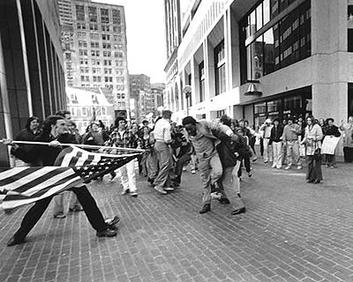Pain, Promise, and the Path to Racial JusticeBy Jim Lynch and Joe Schroeder, AWSA Race is a social construct. The genome has been mapped, and we know that our species share 99.9% of our DNA with one another.1 That “social construct” has very real meaning in our country. Babies who are black and white are born with the same amazing potential. However, based solely on the social construct of race, we can predict wide disparities for people of color in education, criminal justice, health, and poverty. And, here in Wisconsin, we have some of the widest disparities in the nation.2
Two photographs from the same American city capture both the pain of racism and the promise of racial equity in education. The Soiling of Old Glory is a Pulitzer Prize-winning photograph from 1975 of a person who is white, protesting court-ordered desegregation busing in Boston, using the American flag to strike an attorney who is black on his way to work. The second photo is a more recent one of the student body at Boston’s Brockton High School, which shows the vibrancy of American diversity at one of the most recognized schools in America (where the student population has been 61% Black, 21% White, 12% Hispanic, and 3% Asian). For the past four years, Brockton has been honored as a National Model School by the International Center for Leadership in Education. In 2006, Brockton was one of only six schools in the country to receive the National School Change Award. But many more images abound. Through the ongoing protests and unrest arising from the killing of George Floyd in late May, we have all experienced countless images—from a multitude of American communities—that speak to this same pain of racism in pursuit of the promise of racial justice. From our view, we are witnessing the results of centuries of unresolved racial violence. As said by Richard Rohr, “We are hearing the echoing moan of black and brown communities today, crying out, ’How long, O Lord, must our people suffer?’ ” Protests are designed to create cognitive dissonance in those of privilege and power, where cognitive dissonance is the mental discomfort experienced by a person who simultaneously holds two or more contradictory beliefs, ideals, or values. As white males in roles of formal leadership, these protests highlight and chronicle voices of the people who have been marginalized in ways that make us deeply reflect upon how much the ideals of our nation truly are the lived experiences for all of our citizens—and, frankly, how much more work we need to do to realize AWSA’s mission “to increase administrators’ effectiveness in equitably promoting the intellectual, social, and emotional growth of all students.” Essentially, we need to come to grips with the notion that equity change requires systems change, because our educational systems are rooted in a history of marginalization and deficit-based approaches despite our high-minded aims. As leaders in education, we care about cognitive dissonance because this discomfort is essential to any deep transformation or change. And we contend there is no more daunting or worthwhile challenge in education than leading transformation that will promote equitable conditions for all students. Therefore, if we are serious about deeply impacting the lives of all America’s students, we need to clearly illuminate those aspects of ourselves, our systems, and our society (explicit and implicit) that are in contradiction to our stated beliefs and ideals. This is never easy to do, but it is where the growth is. And one of the key reasons that transformational leaders are able to excel in the first place is their ability to “get comfortable about living in discomfort”—and helping others they lead and serve do the same. Whether we lead and live in communities composed of racial diversity or not, we have a uniquely influential position as education leaders to positively impact racial equity; that influence exists both inside and outside the walls of our schools. For example, we know that school leadership has the second-largest impact on student success.3 And last year, a survey by the Pew Research Center found that American adults trust school principals to provide fair and accurate information more than any other public or private leaders. Moreover, there is hope that Americans are now more open to pursuing equity than ever before, as seventy-four percent of Americans support the protests after George Floyd’s killing.4 So how might those of us in positions of privilege and power more impactfully influence the promise of racial justice for all? In his 2019 book, How to Be an Antiracist, Ibram X. Kendi describes a journey of reflection and action to combat racism. As leaders, we need to commit to our own journey to be anti-racist and to use every ounce of our influence to promote equity:
In summary, Dr. Martin Luther King, Jr. believed that, despite the numerous trials and tribulations of our world, “the arc of the universe bends toward justice.” We agree, but meaningful progress will require our engagement and leadership. All of us are fortunate to be in positions to advance equity in our communities and our nation. We hope that recent events spur each of us on to deeply consider, now more than ever: “What are the next steps in my leadership path to bend the universe a little more toward justice for all of our children?” _______________________________________ 1 Why Race is Not a Thing |


